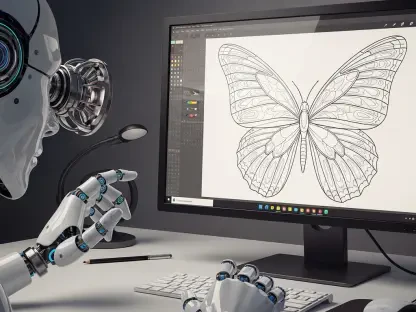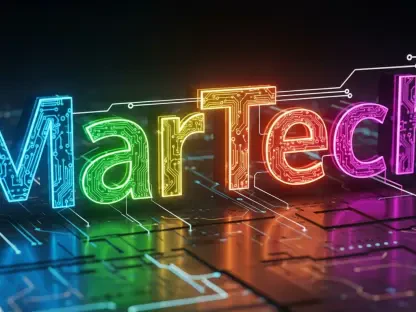Setting the Stage for a Creative Revolution
Imagine a world where a single prompt can produce a novel, a masterpiece painting, or a fully functional piece of software code in mere seconds, transforming the boundaries of human creativity. This is no longer the realm of science fiction but the reality brought forth by Generative Artificial Intelligence (GenAI), a technology that is redefining innovation at an unprecedented pace. With the global AI market projected to reach staggering heights in the coming years, GenAI stands at the forefront, driving transformation across industries like finance, healthcare, and marketing. This review dives deep into the core of this cutting-edge technology, exploring its mechanisms, real-world impact, and the challenges it faces in a rapidly evolving digital landscape. The aim is to provide a clear lens for stakeholders and tech enthusiasts to grasp the profound implications of this revolutionary tool.
Core Principles and Contextual Background
Generative AI distinguishes itself from traditional artificial intelligence by focusing on the creation of original content rather than mere data analysis or classification. At its heart, this technology leverages complex algorithms to generate text, images, audio, video, and code by learning patterns from vast datasets. Unlike conventional AI, which might predict outcomes or categorize information, GenAI produces novel outputs that mimic human creativity, making it a pivotal force in the broader AI ecosystem.
The rise of GenAI aligns with significant advancements in computational power and data availability, positioning it as a cornerstone of modern technological innovation. Its relevance spans multiple sectors, from automating mundane tasks to enabling groundbreaking applications in research and design. This technology is not just a trend but a fundamental shift, reshaping how industries operate and compete in an increasingly digital world.
Defining Features and Technical Underpinnings
Versatility in Content Generation and Multimodality
One of the standout traits of GenAI is its ability to create diverse forms of content, spanning written narratives, visual art, and even musical compositions. This multimodality allows the technology to handle various data types simultaneously, such as generating a video script alongside corresponding visuals. Such versatility opens up a myriad of practical uses, from crafting marketing campaigns to producing educational materials tailored to specific needs.
The significance of this capability lies in its enhancement of user experience and operational efficiency. For instance, businesses can deploy GenAI to create personalized advertisements that resonate with target audiences across different media formats. This cross-functional strength underscores why GenAI is becoming indispensable in environments that demand dynamic and varied content production.
Flexibility and Capacity for Growth
Another critical feature of GenAI is its adaptability, enabling it to tackle new challenges with minimal additional training. This flexibility means that once trained, models can pivot to different tasks, whether refining customer interactions or generating synthetic data for testing purposes. The technical foundation of this adaptability often rests on advanced neural networks that can generalize learned patterns to unfamiliar contexts.
Scalability further complements this trait, allowing GenAI systems to handle increasing workloads or complexity without a drop in performance. Whether deployed on a small scale for a startup or across global enterprise systems, the technology adjusts to demand, ensuring consistent output quality. This combination of adaptability and scalability makes GenAI a robust solution for dynamic, fast-paced industries.
Cutting-Edge Developments and Emerging Patterns
The landscape of GenAI has evolved dramatically, with recent innovations like transformer models and Generative Adversarial Networks (GANs) pushing the boundaries of what is possible. These advancements have enabled more nuanced and realistic content generation, from lifelike images to coherent, context-aware text. The momentum behind these breakthroughs continues to build, shaping a trajectory of relentless progress.
Key trends fueling this growth include the exponential rise in computational resources and the availability of expansive datasets. Additionally, the open-source community plays a vital role, fostering collaboration and accelerating development through shared tools and frameworks. The widespread adoption of mainstream applications has also heightened public and corporate interest, cementing GenAI’s place as a transformative technology.
A notable shift observed is the integration of GenAI into everyday tools and platforms, making advanced capabilities accessible to non-technical users. This democratization is driving innovation at an unprecedented rate, as more organizations experiment with tailored solutions. The ripple effect of these trends suggests a future where GenAI is woven into the fabric of daily operations across sectors.
Practical Implementations Across Industries
GenAI’s real-world applications are as varied as they are impactful, touching nearly every corner of modern industry. In content creation, it automates the production of articles, graphics, and videos, significantly reducing time and cost for media companies. Similarly, in software development, it assists developers by generating code snippets and debugging complex programs with remarkable accuracy.
Beyond creative fields, GenAI is making waves in customer service through intelligent chatbots that offer human-like interactions, improving user satisfaction. In research, particularly in healthcare, it accelerates processes like drug discovery by simulating molecular interactions. A deeper look into finance reveals GenAI’s role in automating analysis, enhancing risk assessment, and delivering personalized customer experiences, positioning it as a game-changer for the sector.
These implementations highlight the technology’s capacity to solve specific pain points while opening new avenues for efficiency. From generating synthetic data for privacy-sensitive applications to prototyping designs in manufacturing, GenAI proves its worth as a versatile tool. Its ability to tailor solutions to unique industry needs underscores the broad appeal and transformative potential it holds.
Hurdles and Constraints in Deployment
Despite its promise, GenAI faces significant challenges that temper its widespread adoption. Technical limitations, such as the risk of biased outputs stemming from flawed training data, pose a persistent issue, often leading to inaccurate or unfair results. Addressing this requires continuous refinement of algorithms to ensure equitable and reliable performance.
Ethical and regulatory concerns also loom large, particularly around intellectual property rights and the potential misuse of generated content. Questions about ownership of AI-created works remain unresolved, creating uncertainty for businesses and creators alike. Moreover, market barriers, including high implementation costs and the need for specialized talent, can hinder smaller organizations from leveraging this technology.
Efforts to overcome these obstacles are underway, with a focus on developing robust governance frameworks and improving model transparency. Collaborative initiatives between industry leaders and policymakers aim to establish guidelines that balance innovation with accountability. While these challenges are daunting, they are not insurmountable, and ongoing progress suggests a path toward more responsible and accessible GenAI deployment.
Horizon of Possibilities Ahead
Looking ahead, GenAI holds immense potential for further breakthroughs that could redefine technological boundaries. Its trajectory hints at a closer alignment with Artificial General Intelligence (AGI), where systems might exhibit broader reasoning and problem-solving capabilities. Such advancements could unlock unprecedented levels of automation and insight across diverse domains.
The long-term impact on industries and society appears profound, with GenAI likely to drive hyper-personalized services and accelerate scientific discovery. However, this future is shaped by evolving factors, including regulatory landscapes and public acceptance. How these elements unfold will determine the pace and direction of GenAI’s integration into everyday life.
Anticipated developments also include more efficient models that require less computational power, broadening access for smaller entities. As technological, ethical, and societal dimensions converge, GenAI’s evolution will likely reflect a delicate balance between innovation and responsibility. This forward-looking perspective emphasizes the need for vigilance and adaptability in harnessing its full potential.
Reflecting on a Groundbreaking Journey
Reflecting on the exploration of Generative AI, it becomes evident that this technology marks a pivotal shift in how creativity and efficiency intertwine across industries. Its ability to generate diverse content, adapt to new challenges, and scale with demand stands out as transformative in the review conducted. The real-world applications, particularly in finance and healthcare, demonstrate tangible benefits that reshape operational paradigms during this assessment.
Challenges like bias, ethical dilemmas, and regulatory gaps emerge as critical areas that demand attention throughout the evaluation. Yet, the strides made in algorithm refinement and governance frameworks offer hope for mitigating these issues as the technology matures. The future, glimpsed through trends and potential breakthroughs, paints a picture of even greater integration and impact in the periods examined.
Moving forward, stakeholders are encouraged to invest in talent development and cross-sector collaboration to address lingering hurdles. Prioritizing ethical guidelines and transparent practices emerges as essential steps to build trust and ensure sustainable growth. As GenAI continues to evolve, staying ahead of regulatory shifts and fostering public dialogue becomes vital actions to maximize its benefits while navigating the complexities it introduces.









